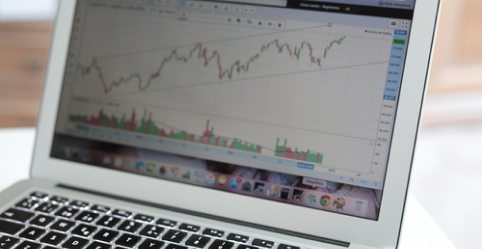Understanding Stock Quote Definitions
One of the first steps to successful investing.

If you’re new to investing, chances are you are feeling overwhelmed by the cluster of confusing terms on stock quote charts. Figuring out how to read a stock chart is like learning a whole new language. However, each of these data points contains useful information about a specific stock, and their meaning can give you a deeper understanding of a stock’s performance and prospects, and help you make better investing decisions.
While each stock quote example is a little different, these terms appear on almost everyone.
Bid/ask
The bid price represents the highest price a buyer is willing to pay for a stock or for another security. The ask price represents the minimum price a buyer will accept for a stock.
Bid and ask prices are different from the current stock price, which is the price of the last trade. It’s important for retail investors to understand that bid represents the demand, while ask represents the supply of the stock. The difference between the two prices is called the spread.
The spread is low for highly traded, or liquid, securities, while for illiquid securities (those that are infrequently traded), the spread is larger. Typically, investors will pay the ask price (this type of purchase is known as a Market Order). However, if they don’t wish to pay more than a specific amount for a security then they must plug that into the trading platform so the order is filled at their preferred price point (this type of purchase is called a Limit Order). A Limit Order transaction does not occur so long as the stock is trading at a value higher than the parameters set in the order.

Bid/ask lots
A lot means 100 shares. Bid lots and ask lots numbers represent the aggregate number of pending trades at a given bid and ask price.
For example, a bid lot of 15 means there are 1,500 shares being offered for purchase at the current bid price. This number has nothing to do with the number of actual sellers, just the aggregate number of shares being offered for purchase. This information could be valuable in anticipating a stock’s price movement.
A larger ask size relative to bid size means more people are trying to sell a stock than buy, which means the stock price will likely trend lower. A larger bid size compared to ask size indicates more people are trying to buy, which means the stock price will likely go up.
A sudden increase in bid or ask volume is typically an indication of an event or something more fundamental that may have happened to the stock that could potentially alter its potential, for better or worse. This requires a closer investigation of a stock’s fundamentals.
Volume
Volume is the total number of shares that are traded (bought and sold) during a day or a specified period of time. Each transaction involves a buyer and a seller and contributes to the total volume count. In other words, even if the same shares are traded back and forth multiple times, the volume is counted on each transaction.
For example, if the same 100 shares are bought and sold five times during a day, the daily volume number would be 500. Volume is closely tied to a stock’s price movement and is therefore an important indicator of momentum. The higher the volume during the price move – up or down – the stronger the move. An increasing price is typically coupled with increased volume.
Dividend yield
A stock’s dividend yield is the ratio of a company’s annual dividend compared to its share price. It’s calculated by dividing the total dividend paid over the most recent year by the current stock price.
Dividend yield is particularly important to those investing for income. Increasing a company’s dividend reflects management’s confidence in the business’ continued earnings power. Investors may want to pay close attention to stocks with an unusually high dividend yield, which could be a function of a stock price falling quickly, since the dividend yield changes with the stock’s price.
Ex-dividend date
If an investor buys a stock that is tagged “ex dividend,” they are not entitled to an upcoming, declared dividend. Investors must buy the stock the day before the ex-dividend date to benefit from the value of the upcoming dividend.
P/E ratio
The price to earnings ratio, or P/E ratio, is a measure of a company’s expected earnings. It’s calculated by dividing a stock’s current share price by the company’s per-share earnings (EPS). Sometimes referred to as a price multiple, a PE ratio helps investors determine the market value of a stock compared to the company’s earnings. The higher the ratio, the greater the amount that an investor is willing to pay for $1 of current earnings.
EPS
In simple terms, earnings per share, or EPS, means how much profit a company has generated during a given period. One of the most common ways to tell how fast a company’s profits are growing is by comparing its most recent EPS to its EPS in previous years and quarters. The higher the EPS, the more money a company has available to either reinvest in the business or distribute to shareholders in the form of dividends. This is a win-win scenario for investors.
52-week high/low
These numbers refer to a stock’s highest and lowest prices reached over the course of the last 52 weeks. It is an indicator that investors can use to determine a stock’s future price movement relative to its current value.
Numerical data points in a stock quote are financial snapshots of publicly traded companies. They serve to provide immediate information that may be used to determine whether or not buying a company’s shares may be a good investment.
Stock data is also an effective way to compare similar-sized companies or companies that are in the same or similar industries. It’s a good idea to understand what all this means before you start trading.
Now that you have a better understanding of how to read a stock chart, you’re ready to make more confident investing decisions. Here’s a handy tip: Bookmark this page for reference, so that you can refer back to it whenever you need a refresh on stock quote terms.
Ready to start investing?
Start investing online with BMO InvestorLine Self-Directed.
Related articles
Have questions?
Quotes in this article have been obtained through phone interviews.
The information contained herein is not, and should not be construed as, investment, tax or legal advice to any party. Investments should be evaluated relative to the individual’s investment objectives and professional advice should be obtained with respect to any circumstance.

